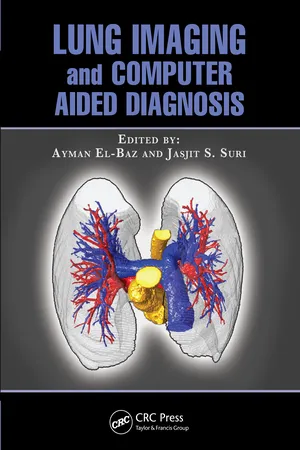
- English
- ePUB (mobile friendly)
- Available on iOS & Android
Lung Imaging and Computer Aided Diagnosis
About this book
In two editions spanning more than a decade, The Electrical Engineering Handbook stands as the definitive reference to the multidisciplinary field of electrical engineering. Our knowledge continues to grow, and so does the Handbook. For the third edition, it has expanded into a set of six books carefully focused on a specialized area or field of study. Each book represents a concise yet definitive collection of key concepts, models, and equations in its respective domain, thoughtfully gathered for convenient access.
Sensors, Nanoscience, Biomedical Engineering, and Instruments provides thorough coverage of sensors, materials and nanoscience, instruments and measurements, and biomedical systems and devices, including all of the basic information required to thoroughly understand each area. It explores the emerging fields of sensors, nanotechnologies, and biological effects. Each article includes defining terms, references, and sources of further information.
Encompassing the work of the world's foremost experts in their respective specialties, Sensors, Nanoscience, Biomedical Engineering, and Instruments features the latest developments, the broadest scope of coverage, and new material on multisensor data fusion and MEMS and NEMS.
Frequently asked questions
- Essential is ideal for learners and professionals who enjoy exploring a wide range of subjects. Access the Essential Library with 800,000+ trusted titles and best-sellers across business, personal growth, and the humanities. Includes unlimited reading time and Standard Read Aloud voice.
- Complete: Perfect for advanced learners and researchers needing full, unrestricted access. Unlock 1.4M+ books across hundreds of subjects, including academic and specialized titles. The Complete Plan also includes advanced features like Premium Read Aloud and Research Assistant.
Please note we cannot support devices running on iOS 13 and Android 7 or earlier. Learn more about using the app.
Information
Table of contents
- Cover
- Halftitle Page
- Title Page
- Copyright Page
- Table of Contents
- Editors
- Contributors
- 1 A Novel Three-Dimensional Framework for Automatic Lung Segmentation from Low-Dose Computed Tomography Images
- 2 Incremental Engineering of Lung Segmentation Systems
- 3 3D MGRF-Based Appearance Modeling for Robust Segmentation of Pulmonary Nodules in 3D LDCT Chest Images
- 4 Ground-Glass Nodule Characterization in High-Resolution Computed Tomography Scans
- 5 Four-Dimensional Computed Tomography Lung Registration Methods
- 6 Pulmonary Kinematics via Registration of Serial Lung Images
- 7 Acquisition and Automated Analysis of Normal and Pathological Lungs in Small Animals Using Microcomputed Tomography
- 8 Airway Segmentation and Analysis from Computed Tomography
- 9 Pulmonary Vessel Segmentation for Multislice CT Data: Methods and Applications
- 10 A Novel Level Set-Based Computer-Aided Detection System for Automatic Detection of Lung Nodules in Low-Dose Chest Computed Tomography Scans
- 11 Model-Based Methods for Detection of Pulmonary Nodules
- 12 Concept and Practice of Genetic Algorithm Template Matching and Higher Order Local Autocorrelation Schemes in Automated Detection of Lung Nodules
- 13 Computer-Aided Detection of Lung Nodules in Chest Radiographs and Thoracic CT
- 14 Lung Nodule and Tumor Detection and Segmentation
- 15 Texture Classification in Pulmonary CT
- 16 Computer-Aided Assessment and Stenting of Tracheal Stenosis
- 17 Appearance Analysis for the Early Assessment of Detected Lung Nodules
- 18 Validation of a New Image-Based Approach for the Accurate Estimating of the Growth Rate of Detected Lung Nodules Using Real Computed Tomography Images and Elastic Phantoms Generated by State-of-the-Art Microfluidics Technology
- 19 Three-Dimensional Shape Analysis Using Spherical Harmonics for Early Assessment of Detected Lung Nodules
- 20 Review on Computer-Aided Detection, Diagnosis, and Characterization of Pulmonary Nodules: A Clinical Perspective